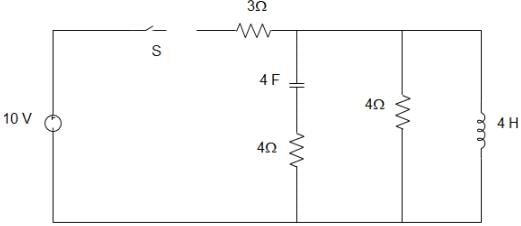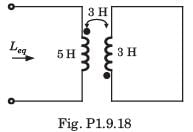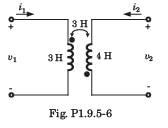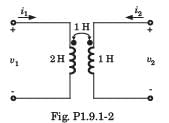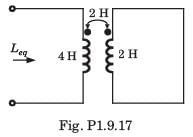All Exams >
Electrical Engineering (EE) >
6 Months Preparation for GATE Electrical >
All Questions
All questions of Magnetically Coupled Circuits for Electrical Engineering (EE) Exam
In inductive circuit, when inductance (L) or inductive reactance (XL) increases, the circuit current- a)also increases
- b)decreases
- c)remains same
- d)None of the above
Correct answer is option 'B'. Can you explain this answer?
In inductive circuit, when inductance (L) or inductive reactance (XL) increases, the circuit current
a)
also increases
b)
decreases
c)
remains same
d)
None of the above

|
Ashwani Mishra answered |
Concept:
The current in an inductive circuit is given by:
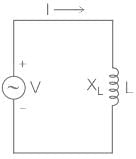
I = V/XL
where I = Current
V = Voltage
XL = Inductive reactance
Explanation:
- XL is inversely proportional to the current.
- Hence, with an increase in the inductive reactance, the current decreases.
An iron-cored coil has an inductance of 4 H. If the reluctance of the flux path is 100 AT/Wb, then the number of turns in the coil is:- a)400
- b)200
- c)20
- d)40
Correct answer is option 'C'. Can you explain this answer?
An iron-cored coil has an inductance of 4 H. If the reluctance of the flux path is 100 AT/Wb, then the number of turns in the coil is:
a)
400
b)
200
c)
20
d)
40

|
Ashwani Mishra answered |
Concept:
Self-Inductance
Self-Inductance

Here, A = Area
N = Number of turns
l = Length of coil
magnetic flux 

Reluctance s = N2 / L.......(i)
Calculation:
L = 4 H, s = 100 AT / Wb
From equation (i)
N = √4×100
= 20
Two coils with self-inductance of 100 mH and 200 mH and mutual inductance of 50 mH are connected in parallel aiding order. What will be the total inductance of the combination?- a)250 mH
- b)4
- c)75 mH3.175 mH
- d)87.5 mH
Correct answer is option 'D'. Can you explain this answer?
Two coils with self-inductance of 100 mH and 200 mH and mutual inductance of 50 mH are connected in parallel aiding order. What will be the total inductance of the combination?
a)
250 mH
b)
4
c)
75 mH3.175 mH
d)
87.5 mH

|
Ashwani Mishra answered |
Concept:
The equivalent inductance of series aiding connection is
 L = L1 + L2 + 2M
L = L1 + L2 + 2MThe equivalent inductance of series opposing connection is

L = L1 + L2 – 2M
Equivalent inductance of parallel aiding connection is
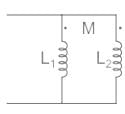

Equivalent inductance of parallel opposing connection is
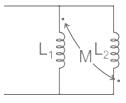

Calculation:
Given,
L1 = 100 mH
L2 = 200 mH
M = 50 mH
Inductance of parallel aiding connection is
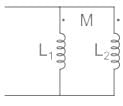

A pure inductor of 20.0 mH is connected to a source of 220 V. Find the RMS value of current in the circuit, if the frequency of the source is 50 Hz.- a)8.8 A
- b)35.03 A
- c)3.5 A
- d)88 A
Correct answer is option 'B'. Can you explain this answer?
A pure inductor of 20.0 mH is connected to a source of 220 V. Find the RMS value of current in the circuit, if the frequency of the source is 50 Hz.
a)
8.8 A
b)
35.03 A
c)
3.5 A
d)
88 A
|
|
Zoya Sharma answered |
Concept:
Inductive reactance:
- The inductive reactance is the opposition offered by the inductor in an AC circuit to the flow of ac current.
- Its SI unit is ohm(Ω).
- The inductive reactance is given as,
⇒ XL = 2πfL
Where f = frequency of ac current and L = self - inductance of the coil
Impedance:
- Impedance is essentially everything that obstructs the flow of electrons within an electrical circuit.
- For a pure inductor, the inductive reactance is equal to the impedance.
AC voltage applied to an inductor:
- When an AC voltage is applied to an inductor, the current in the circuit is given as,
⇒ I = V / XL
- In a pure inductor circuit, the current reaches its maximum value later than the voltage by one-fourth of a period.
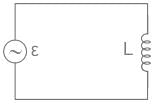
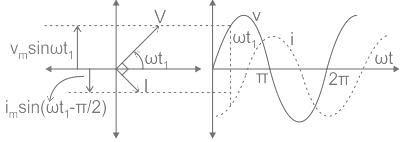
Calculation:
Given Vrms = 220 V
L = 20 mH = 20 × 10-3 H
f = 50 Hz
Inductive reactance is given as,
⇒ XL = 2πfL
⇒ XL = 2π × 50 × 20 × 10-3
⇒ XL = 6.28 Ω
When an AC voltage is applied to an inductor, the current in the circuit is given as,
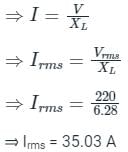
An air-cored solenoid has 100 turns and is 1 m long. If the area of the cross section is 100 cm2, what will be its self-inductance (in μH)?- a)400 π
- b)4 π
- c)40 π
- d)0.4 π
Correct answer is option 'C'. Can you explain this answer?
An air-cored solenoid has 100 turns and is 1 m long. If the area of the cross section is 100 cm2, what will be its self-inductance (in μH)?
a)
400 π
b)
4 π
c)
40 π
d)
0.4 π
|
|
Jyoti Basak answered |
Understanding Self-Inductance of a Solenoid
To find the self-inductance of an air-cored solenoid, we can use the formula:
L = (μ₀ * N² * A) / l
Where:
- L = self-inductance (in henries)
- μ₀ = permeability of free space (4π x 10^-7 H/m)
- N = number of turns
- A = cross-sectional area (in m²)
- l = length of the solenoid (in m)
Given Values
- Number of turns, N = 100
- Length of the solenoid, l = 1 m
- Cross-sectional area, A = 100 cm² = 0.01 m² (conversion from cm² to m²)
Calculating Self-Inductance
1. Convert Area:
A = 100 cm² = 0.01 m²
2. Apply the Formula:
Plugging in the values:
L = (4π x 10^-7 H/m * (100)² * 0.01 m²) / 1 m
3. Calculating Step-by-Step:
- N² = 10000
- L = (4π x 10^-7 * 10000 * 0.01)
- L = (4π x 10^-7 * 100)
- L = 4π x 10^-5 H
4. Convert to Microhenries:
- 1 H = 10^6 μH
- L = 4π x 10^-5 H = 40π μH
Final Result
The self-inductance of the solenoid is 40π μH, which matches option 'C'. This thorough calculation details the steps and confirms the correctness of the self-inductance value.
To find the self-inductance of an air-cored solenoid, we can use the formula:
L = (μ₀ * N² * A) / l
Where:
- L = self-inductance (in henries)
- μ₀ = permeability of free space (4π x 10^-7 H/m)
- N = number of turns
- A = cross-sectional area (in m²)
- l = length of the solenoid (in m)
Given Values
- Number of turns, N = 100
- Length of the solenoid, l = 1 m
- Cross-sectional area, A = 100 cm² = 0.01 m² (conversion from cm² to m²)
Calculating Self-Inductance
1. Convert Area:
A = 100 cm² = 0.01 m²
2. Apply the Formula:
Plugging in the values:
L = (4π x 10^-7 H/m * (100)² * 0.01 m²) / 1 m
3. Calculating Step-by-Step:
- N² = 10000
- L = (4π x 10^-7 * 10000 * 0.01)
- L = (4π x 10^-7 * 100)
- L = 4π x 10^-5 H
4. Convert to Microhenries:
- 1 H = 10^6 μH
- L = 4π x 10^-5 H = 40π μH
Final Result
The self-inductance of the solenoid is 40π μH, which matches option 'C'. This thorough calculation details the steps and confirms the correctness of the self-inductance value.
An ideal capacitor is charged to a voltage VO and connected at t=0 across an ideal inductor L. If ω = 1 / √LC, the voltage across the capacitor at time t > 0 is ________- a)VO
- b)VO cos(ωt)
- c)VO sin(ωt)
- d)VO e-ωtcos(ωt)
Correct answer is option 'B'. Can you explain this answer?
An ideal capacitor is charged to a voltage VO and connected at t=0 across an ideal inductor L. If ω = 1 / √LC, the voltage across the capacitor at time t > 0 is ________
a)
VO
b)
VO cos(ωt)
c)
VO sin(ωt)
d)
VO e-ωtcos(ωt)

|
Naroj Boda answered |
Voltage across capacitor will discharge through inductor up to voltage across the capacitor becomes zero. Now, inductor will start charging capacitor.
Voltage across capacitor will be decreasing from VO and periodic and is not decaying since both L and C is ideal.
∴ Voltage across the capacitor at time t > 0 is VO cos(ωt).
Voltage across capacitor will be decreasing from VO and periodic and is not decaying since both L and C is ideal.
∴ Voltage across the capacitor at time t > 0 is VO cos(ωt).
The equivalent inductance of a pair of a coupled inductor in various configuration are
(a) 7 H after series adding connection
(b) 1.8 H after series opposing connection
(c) 0.5 H after parallel connection with dotted terminal connected together.
The value of L1 ,L2 and M are- a)3 H, 1.6 H, 1.2 H
- b)1.6 H, 3 H, 1.4 H
- c)3.7 H, 0.7 H, 1.3 H
- d)2 H, 3 H, 3 H
Correct answer is option 'C'. Can you explain this answer?
The equivalent inductance of a pair of a coupled inductor in various configuration are
(a) 7 H after series adding connection
(b) 1.8 H after series opposing connection
(c) 0.5 H after parallel connection with dotted terminal connected together.
The value of L1 ,L2 and M are
(a) 7 H after series adding connection
(b) 1.8 H after series opposing connection
(c) 0.5 H after parallel connection with dotted terminal connected together.
The value of L1 ,L2 and M are
a)
3 H, 1.6 H, 1.2 H
b)
1.6 H, 3 H, 1.4 H
c)
3.7 H, 0.7 H, 1.3 H
d)
2 H, 3 H, 3 H
|
|
Ravi Singh answered |

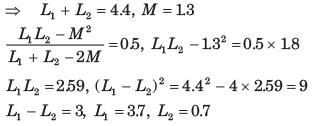
Inductance of a solenoid of 2500 turns wound uniformly over a length of 0.5 m cylindrical paper tube of 4 cm diameter in air medium is around:- a)19.6 mH
- b)196 mH
- c)1.96 H
- d)1.96 mH
Correct answer is option 'A'. Can you explain this answer?
Inductance of a solenoid of 2500 turns wound uniformly over a length of 0.5 m cylindrical paper tube of 4 cm diameter in air medium is around:
a)
19.6 mH
b)
196 mH
c)
1.96 H
d)
1.96 mH
|
|
Zoya Sharma answered |
Given that, number of turns (N) = 2500
Diameter (d) = 4 cm
Length (l) = 0.5 m
The value of permeability in air is taken as 4π × 10-7.
Self-inductance of a solenoid is given by:

The inductance of a single layer coil of 50 turns is 5 mH. If the no. of turns is doubled, the inductance of the coil will become ______- a)2.5 mH
- b)5 mH
- c)10 mH
- d)20 mH
Correct answer is option 'D'. Can you explain this answer?
The inductance of a single layer coil of 50 turns is 5 mH. If the no. of turns is doubled, the inductance of the coil will become ______
a)
2.5 mH
b)
5 mH
c)
10 mH
d)
20 mH
|
|
Zoya Sharma answered |
Concept:
The formula for inductance of a coil is
L = μN2A / l
N is no. of turns
A is the cross-sectional area
l length of the solenoid
L ∝ N2 / l
L2L1 = (N2 / N1)2 x l1l2
Calculation:
Given:
L1 = 5 mH, N1 = 50 turns
Now, The number of turns is doubled i.e.
N2 = 2N1 = 100
l2 = l1 = l

L2 = 20 mH
A 500 W discharge lamp takes a current of 4 A at unity p.f. Find the inductance of a choke required to enable the lamp to work on 250 V, 50 Hz main.- a)1.72 mH
- b)17.2 mH
- c)0.172 H
- d)0.172 mH
Correct answer is option 'C'. Can you explain this answer?
A 500 W discharge lamp takes a current of 4 A at unity p.f. Find the inductance of a choke required to enable the lamp to work on 250 V, 50 Hz main.
a)
1.72 mH
b)
17.2 mH
c)
0.172 H
d)
0.172 mH
|
|
Pooja Patel answered |
Concept :
Choke coil (or ballast) is a device having high inductance and negligible resistance. It is used to control current in ac circuits and is used in fluorescent tubes. The power loss in a circuit containing choke coil is least.
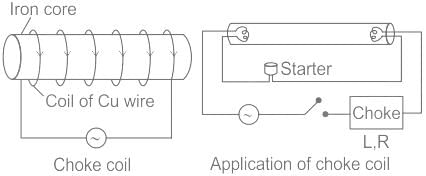
(1) It consist of a Cu coil wound over a soft iron laminated core
(2) Thick Cu wire is used to reduce the resistance (R) of the circuit
(3) Soft iron is used to improve inductance (L) of the circuit
(4) The inductive reactance or effective opposition of the choke cost is given by XL = 2πfL
(5) For an ideal choke coil r= 0, no electric energy is wasted i.e. average power P=0
6) In actual practice choke coil is equivalent to a R-L circuit.
(7) Choke coil for different frequencies are made by using different substances in their core.
For low frequency L should be large thus iron core choke coil is used. For high frequency ac circuit, L should be small, so air cored choke coil is used.
Calculations:
P = I2 R

XL = 2 π f L
L= XL / 2πf
Given
P = 500 W
I = 4 A
V = 250 V
f = 50 Hz
pf = unity
R = P / I2 = 500 / 16 = 31.25 Ω
Z = V / I = 250 / 4 = 62.5 Ω
XL = 54.125 Ω
L = XL / (2π f) = 0.1732 H
In the figure given below, what is the RMS value of the periodic waveform?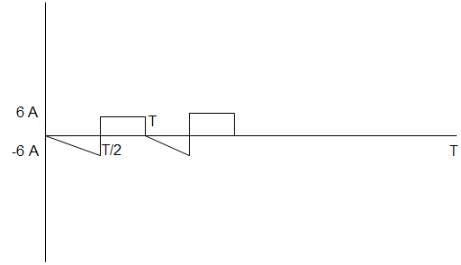
- a)2√6 A
- b)6√2 A
- c)

- d)1.5 A
Correct answer is option 'A'. Can you explain this answer?
In the figure given below, what is the RMS value of the periodic waveform?

a)
2√6 A
b)
6√2 A
c)

d)
1.5 A
|
|
Zoya Sharma answered |
The rms value for any waveform is
= 

= 

= 

= [6 + 18]1/2 = √24 = 2√ 6 A.
In the circuit shown below the current I(t) for t≥0+ (assuming zero initial conditions) is ___________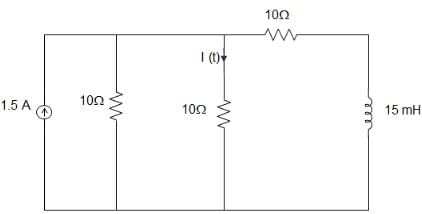
- a)0.5-0.125e-1000t A
- b)1.5-0.125e-1000t A
- c)0.5-0.5e-1000t A
- d)0.375e-1000t A
Correct answer is option 'A'. Can you explain this answer?
In the circuit shown below the current I(t) for t≥0+ (assuming zero initial conditions) is ___________

a)
0.5-0.125e-1000t A
b)
1.5-0.125e-1000t A
c)
0.5-0.5e-1000t A
d)
0.375e-1000t A
|
|
Zoya Sharma answered |
I (t) = 1.5 / 3 = 0.5
LEQ = 15 mH
REQ = 5+10 = 15Ω
LEQ = 15 mH
REQ = 5+10 = 15Ω

I (t) A – (A – B) e-t = 0.5 – (0.5-B) e-1000t
= 0.5(0.5 – 0.375) e-1000t
= 0.5 – 0.125 e-1000t
I (t) = 0.5-0.125e-1000t.
= 0.5(0.5 – 0.375) e-1000t
= 0.5 – 0.125 e-1000t
I (t) = 0.5-0.125e-1000t.
The SI unit of circuit element inductance is:- a)Ohm
- b)Volt
- c)Faraday
- d)Henry
Correct answer is option 'D'. Can you explain this answer?
The SI unit of circuit element inductance is:
a)
Ohm
b)
Volt
c)
Faraday
d)
Henry

|
EduRev GATE answered |
Concept:
- Induction: It is the magnetic field that is proportional to the rate of change of the magnetic field.
- This definition of induction holds for a conductor. Induction is also known as inductance.
- L is used to represent the inductance and Henry is the SI unit of inductance.
- 1 Henry is defined as the amount of inductance required to produce an emf of 1 volt in a conductor when the current change in the conductor is at the rate of 1 Ampere per second.
- Following are the factors that affect the inductance:
(i) The number of turns of the wire used in the inductor.
(ii) The material used in the core.
(iii) The shape of the core. - Electromagnetic Induction: The law was given by Faraday which states that by varying the magnetic flux electromotive force is induced in the circuit.
- Inductance: It can be defined as the electromotive force generated to oppose the change in current at a particular time duration.
According to Faraday’s Law:

Initial voltage on capacitor VO as marked |VO| = 5 V, VS = 8 u (t), where u (t) is the unit step. The voltage marked V at t=0+ is _____________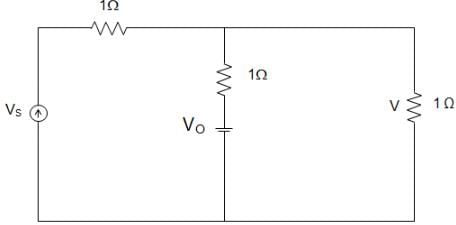
- a)1 V
- b)-1 V
- c) 13/3 V
- d)–13/3 V
Correct answer is option 'C'. Can you explain this answer?
Initial voltage on capacitor VO as marked |VO| = 5 V, VS = 8 u (t), where u (t) is the unit step. The voltage marked V at t=0+ is _____________

a)
1 V
b)
-1 V
c)
13/3 V
d)
–13/3 V

|
Cstoppers Instructors answered |
Applying voltage divider method, we get,

And, 

= 

Now, 

= 

Hence, the net current in 1Ω resistance = I1 + I′1
= 

∴ Voltage drop across 1Ω = 13/3×1
= 13/3 V.
= 13/3 V.
In the circuit given below, for time t < 0, S1 remained closed and S2 open., S1 is initially opened and S2 is initially closed. If the voltage V2 across the capacitor C2 at t = 0 is zero, the voltage across the capacitor combination at t = 0+ will be ____________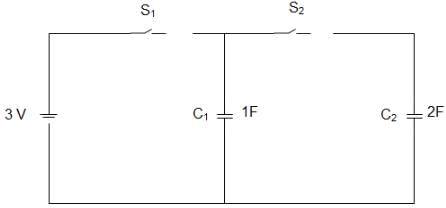
- a)1 V
- b)2 V
- c)1.5 V
- d)3 V
Correct answer is option 'D'. Can you explain this answer?
In the circuit given below, for time t < 0, S1 remained closed and S2 open., S1 is initially opened and S2 is initially closed. If the voltage V2 across the capacitor C2 at t = 0 is zero, the voltage across the capacitor combination at t = 0+ will be ____________

a)
1 V
b)
2 V
c)
1.5 V
d)
3 V

|
Cstoppers Instructors answered |
When S1 is closed and S2 is open,
VC1 (0–) = VC1 (0+) = 3V
When S1 is opened and S2 is closed, VC2 (0+) = VC2 (0+) = 3V.
VC1 (0–) = VC1 (0+) = 3V
When S1 is opened and S2 is closed, VC2 (0+) = VC2 (0+) = 3V.
If both the number of turns and core length of an inductive coil are doubled, then its self inductance will be- a)halved
- b)doubled
- c)quadrupled
- d)unaffected
Correct answer is option 'B'. Can you explain this answer?
If both the number of turns and core length of an inductive coil are doubled, then its self inductance will be
a)
halved
b)
doubled
c)
quadrupled
d)
unaffected

|
Gate Funda answered |
CONCEPT:
Self-Induction
- Whenever the electric current passing through a coil changes, the magnetic flux linked with it will also change.
- As a result of this, in accordance with Faraday’s laws of electromagnetic induction, an emf is induced in the coil which opposes the change that causes it.
- This phenomenon is called ‘self-induction’ and the emf induced is called back emf, current so produced in the coil is called induced current.
- Self-inductance of a solenoid is given by –
⇒ 

Where μo = Absolute permeability, N = Number of turns, l = length of the solenoid, and A = Area of the solenoid.
Given - l2 = 2l1
N2 = 2 N1
Self-inductance of a solenoid is given by:
⇒ 



⇒ 

⇒ 

L2 = 2 L1
What is the power dissipation (in W) in an ideal inductor having an inductance of 0.2 H? - a)-0.04
- b)-0.2 1
- c)0
- d)0.04
Correct answer is option 'C'. Can you explain this answer?
What is the power dissipation (in W) in an ideal inductor having an inductance of 0.2 H?
a)
-0.04
b)
-0.2 1
c)
0
d)
0.04
|
|
Dishani Bose answered |
Power Dissipation in an Ideal Inductor
In an ideal inductor, the power dissipation is zero. This is because an ideal inductor has zero resistance and therefore does not dissipate any power in the form of heat.
Explanation:
Inductors are passive electrical components that store energy in their magnetic field. When a current flows through an inductor, it creates a magnetic field around it. The energy stored in this magnetic field is given by the equation:
E = 0.5 * L * I^2
Where:
E is the energy stored in the inductor (in joules),
L is the inductance of the inductor (in henries), and
I is the current flowing through the inductor (in amperes).
Since power is the rate at which energy is transferred, the power dissipated by an inductor can be calculated by differentiating the energy with respect to time:
P = dE/dt
However, in the case of an ideal inductor, the inductor has no resistance, which means that there is no power dissipated as heat. In other words, an ideal inductor does not convert electrical energy into heat energy.
Conclusion:
Therefore, the power dissipation in an ideal inductor is zero (0 W). This is because an ideal inductor has zero resistance and does not dissipate any power in the form of heat.
In an ideal inductor, the power dissipation is zero. This is because an ideal inductor has zero resistance and therefore does not dissipate any power in the form of heat.
Explanation:
Inductors are passive electrical components that store energy in their magnetic field. When a current flows through an inductor, it creates a magnetic field around it. The energy stored in this magnetic field is given by the equation:
E = 0.5 * L * I^2
Where:
E is the energy stored in the inductor (in joules),
L is the inductance of the inductor (in henries), and
I is the current flowing through the inductor (in amperes).
Since power is the rate at which energy is transferred, the power dissipated by an inductor can be calculated by differentiating the energy with respect to time:
P = dE/dt
However, in the case of an ideal inductor, the inductor has no resistance, which means that there is no power dissipated as heat. In other words, an ideal inductor does not convert electrical energy into heat energy.
Conclusion:
Therefore, the power dissipation in an ideal inductor is zero (0 W). This is because an ideal inductor has zero resistance and does not dissipate any power in the form of heat.
Two coils in differential connection have a self-inductance of 2 mH and 4 mH and mutual inductance of 0.15 mH. The equivalent inductance of the series opposing combination will be:- a)5.9 mH
- b)6.5 mH
- c)5.7 mH
- d)7 mH
Correct answer is option 'C'. Can you explain this answer?
Two coils in differential connection have a self-inductance of 2 mH and 4 mH and mutual inductance of 0.15 mH. The equivalent inductance of the series opposing combination will be:
a)
5.9 mH
b)
6.5 mH
c)
5.7 mH
d)
7 mH
|
|
Zoya Sharma answered |
Concept:
Series Aiding:

The equivalent inductance of series aiding connection is:
Leq = L1 + L2 + 2M
Series Opposing:

The equivalent inductance of series opposing connection is:
Leq = L1 + L2 – 2M
Calculation:
Given,
L1 = 2 mH
L2 = 4 mH
M = 0.15 mH
And connected with series opposing polarity.
From above concept,
Leq = L1 + L2 - 2M
Leq = 2 + 4 - 2 (0.15)
Leq = 5.7 mH
In the circuit given below, the input impedance ZIN of the circuit is _________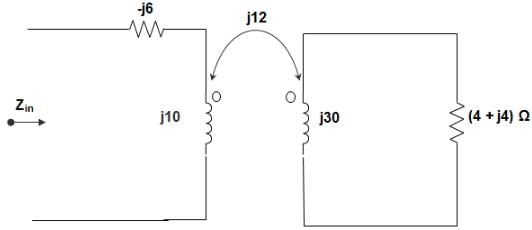
- a)0.52 – j4.30 Ω
- b)0.52 + j15.70 Ω
- c)64.73 + j17.77 Ω
- d)0.3 – j33.66 Ω
Correct answer is option 'C'. Can you explain this answer?
In the circuit given below, the input impedance ZIN of the circuit is _________

a)
0.52 – j4.30 Ω
b)
0.52 + j15.70 Ω
c)
64.73 + j17.77 Ω
d)
0.3 – j33.66 Ω
|
|
Pooja Patel answered |
ZIN = (-6j) || (ZA)

= 0.49 + j5.82

= 64.73 + j17.77 Ω.
In the circuit given below, the switch S1 is initially closed and S2 is opened. The inductor L carries a current of 10A and the capacitor is charged to 10 V with polarities as shown. The current through L during t=0+ is _____________
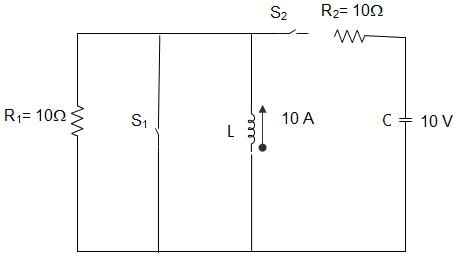
- a)55 A
- b)5.5 A
- c)45 A
- d)4.5 A
Correct answer is option 'A'. Can you explain this answer?
In the circuit given below, the switch S1 is initially closed and S2 is opened. The inductor L carries a current of 10A and the capacitor is charged to 10 V with polarities as shown. The current through L during t=0+ is _____________


a)
55 A
b)
5.5 A
c)
45 A
d)
4.5 A

|
Cstoppers Instructors answered |
By KCL, we get,

Hence, 2 VL = 110
∴ VL = 55 V.
∴ VL = 55 V.
A series RLC circuit has a resonance frequency of 1 kHz and a quality factor Q = 100. If each of R, L and C is doubled from its original value, the new Q of the circuit is _____________- a)25
- b)50
- c)100
- d)200
Correct answer is option 'B'. Can you explain this answer?
A series RLC circuit has a resonance frequency of 1 kHz and a quality factor Q = 100. If each of R, L and C is doubled from its original value, the new Q of the circuit is _____________
a)
25
b)
50
c)
100
d)
200
|
|
Luminary Institute answered |
Q = f0 / BW
And f0 = 1/2π (LC)0.5
BW = R/L
or, Q = 1R(L/C)0.5
When R, L and C are doubled, Q’ = 50.
And f0 = 1/2π (LC)0.5
BW = R/L
or, Q = 1R(L/C)0.5
When R, L and C are doubled, Q’ = 50.
A rectangular voltage wave of magnitude A and duration B is applied to a series combination of resistance R and capacitance C. The voltage developed across the capacitor is ____________- a)A[1 – exp(-B/RC)]
- b) AB/RC
- c)A
- d)A exp(-B/RC)
Correct answer is option 'A'. Can you explain this answer?
A rectangular voltage wave of magnitude A and duration B is applied to a series combination of resistance R and capacitance C. The voltage developed across the capacitor is ____________
a)
A[1 – exp(-B/RC)]
b)
AB/RC
c)
A
d)
A exp(-B/RC)
|
|
Zoya Sharma answered |


Hence, maximum voltage =
V [1 – exp (-B/RC)].
V [1 – exp (-B/RC)].
An iron cored coil with 1000 turns generates a magnetic flux of 500 μwb in the core while carrying an electric current of 50 A. What will be the self-inductance of the coil?- a)0.01 H
- b)0.1 H
- c)0.1 mH
- d)0.01 mH
Correct answer is option 'A'. Can you explain this answer?
An iron cored coil with 1000 turns generates a magnetic flux of 500 μwb in the core while carrying an electric current of 50 A. What will be the self-inductance of the coil?
a)
0.01 H
b)
0.1 H
c)
0.1 mH
d)
0.01 mH
|
|
Zoya Sharma answered |
Concept:
Self-inductance

Here, A = Area
N = Number of turns
l = Length of coil
magnetic flux 

Calculation:
N= 1000, ϕ = 500 μwb, I = 50 A
Rl = reluctance
ϕ = (1000 × 50 ) / Rl

Rl = 108

L = 0.01 H
When a dc voltage of 60 V is applied across a solenoid, an electric current of 5 A flows through it. When the dc voltage is replaced by the ac voltage of the angular frequency 400 rad/s, the electric current is reduced to 3A. What is the inductance of solenoid?- a)0.02 H
- b)0.4 H
- c)0.04 H
- d)0.2 H
Correct answer is option 'C'. Can you explain this answer?
When a dc voltage of 60 V is applied across a solenoid, an electric current of 5 A flows through it. When the dc voltage is replaced by the ac voltage of the angular frequency 400 rad/s, the electric current is reduced to 3A. What is the inductance of solenoid?
a)
0.02 H
b)
0.4 H
c)
0.04 H
d)
0.2 H

|
Ashwani Mishra answered |
Concept:
Solenoid:
A type of electromagnet that generates a controlled magnetic field through a coil wound into a tightly packed helix.
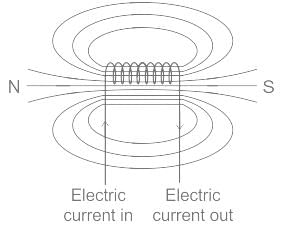
- The uniform magnetic field is produced when an electric current is passed through it.
- The magnetic field inside a solenoid does not depend on the diameter of the solenoid.
- The field inside is constant.
Calculation:
Given: Vdc = 60 V, Idc = 5 A
Solenoid equivalent is given by series RL circuit.
Now by DC supply, the inductor behaves as a short circuit at a steady state.
Vdc = Idc × R = 5 × R = 60
R = 12 Ω
Now, when AC supply is given, Current Iac = 3 A at ω = 400 rad/sec
Equivalent impedance(Z) = V/I = 60/3 = 20Ω
Therefore,


ωL = 16 Ω
L = 16/400 = 0.04 H
If the number of turns in a coil is doubled in the same length and area, the inductance L will- a)double
- b)quadruple
- c)remains the same
- d)be cut in half
Correct answer is option 'B'. Can you explain this answer?
If the number of turns in a coil is doubled in the same length and area, the inductance L will
a)
double
b)
quadruple
c)
remains the same
d)
be cut in half
|
|
Zoya Sharma answered |
Concept:
The inductance of a coil is given by:

N = number of turns in the coil
A = Area of the cross-section
l = length of the coil
μ = magnetic permeability of the coil
Application:

With N2 = 2 × N1, A2 = A1 and l2 = l1

∴ If the number of turns in a coil is doubled in the same length and area, the inductance L will quadruple.
Two coils having self-inductance of 18 H and 2 H, respectively, are magnetically coupled and the mutual inductance between them is 3 H. Find the value of coefficient of coupling.- a)0.75
- b)0.50
- c)0.25
- d)0.60
Correct answer is option 'B'. Can you explain this answer?
Two coils having self-inductance of 18 H and 2 H, respectively, are magnetically coupled and the mutual inductance between them is 3 H. Find the value of coefficient of coupling.
a)
0.75
b)
0.50
c)
0.25
d)
0.60
|
|
Zoya Sharma answered |
Concept:
Coefficient of Coupling (k):
The coefficient of coupling (k) between two coils is defined as the fraction of magnetic flux produced by the current in one coil that links the other.
The coefficient of coupling (k) between two coils is defined as the fraction of magnetic flux produced by the current in one coil that links the other.
Two coils have self-inductance L1 and L2, then mutual inductance M between them then Coefficient of Coupling (k) is given by

Where,
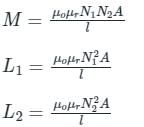
N1 and N2 is the number of turns in coil 1 and coil 2 respectively
A is the cross-section area
l is the length
A is the cross-section area
l is the length
Calculation:
Given,
L1 = 18 H
L2 = 2 H
M = 3 H
From the above concept,

For a unit step signal u (t), the response is V1 (t) = (1-e-3t) for t>0. If a signal 3u (t) + δ(t) is applied, the response will be (considering zero initial conditions)?- a)(3 - 6e-3t)u(t)
- b)(3 - 3e-3t)u(t)
- c)3u(t)
- d)(3 + 3e-3t)u(t)
Correct answer is option 'C'. Can you explain this answer?
For a unit step signal u (t), the response is V1 (t) = (1-e-3t) for t>0. If a signal 3u (t) + δ(t) is applied, the response will be (considering zero initial conditions)?
a)
(3 - 6e-3t)u(t)
b)
(3 - 3e-3t)u(t)
c)
3u(t)
d)
(3 + 3e-3t)u(t)

|
Naroj Boda answered |
For u (t) = 1, t > 0
V1 (t) = (1 - e-3t)
V1 (t) = (1 - e-3t)
or, 

Ans, 

Now, for 

Response, H(s) = R(s)

Or, h (t) = 3 u (t).
In the circuit shown, the voltage source supplies power which is _____________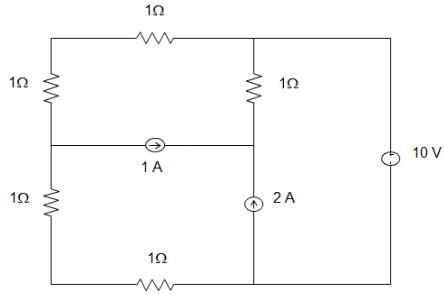
- a)Zero
- b)5 W
- c)10 W
- d)100 W
Correct answer is option 'A'. Can you explain this answer?
In the circuit shown, the voltage source supplies power which is _____________

a)
Zero
b)
5 W
c)
10 W
d)
100 W
|
|
Pooja Patel answered |
Let the current supplied by a voltage source.
Applying KVL in outer loop,
10 – (I + 3) × (I + 1) – (I + 2) × 2 = 0
10 – 2(I + 3) – 2(I - 2) = 0
Or, I = 0
∴ Power VI = 0.
Applying KVL in outer loop,
10 – (I + 3) × (I + 1) – (I + 2) × 2 = 0
10 – 2(I + 3) – 2(I - 2) = 0
Or, I = 0
∴ Power VI = 0.
The switch in the circuit shown was on position X for a long time. The switch is then moved to position Y at time t=0. The current I(t) for t > 0 is ________
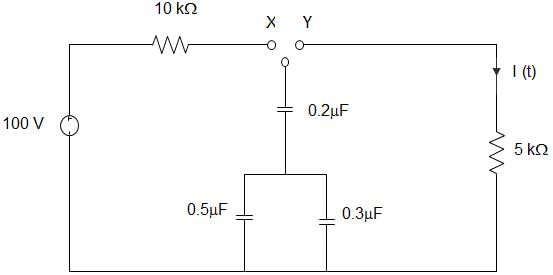
- a)0.2e-125tu(t) mA
- b)20e-1250tu(t) mA
- c)0.2e-1250tu(t) mA
- d)20e-1000tu(t) mA
Correct answer is option 'C'. Can you explain this answer?
The switch in the circuit shown was on position X for a long time. The switch is then moved to position Y at time t=0. The current I(t) for t > 0 is ________

a)
0.2e-125tu(t) mA
b)
20e-1250tu(t) mA
c)
0.2e-1250tu(t) mA
d)
20e-1000tu(t) mA

|
Naroj Boda answered |

VC (t = 0–) = 100 V
At t ≥ 0,
The discharging current
At t ≥ 0,
The discharging current

= 

= 0.2e-1250tu(t) mA.
If a brass core of an inductor is replaced by an iron core, the inductance of coil:- a)Increases
- b)Decreases
- c)Does not change
- d)Will be zero
Correct answer is option 'A'. Can you explain this answer?
If a brass core of an inductor is replaced by an iron core, the inductance of coil:
a)
Increases
b)
Decreases
c)
Does not change
d)
Will be zero

|
Gate Funda answered |
The inductance of an inductor is primarily determined by four factors:
- The type of core material
- The number of turns of wire
- The spacing between turns of wire
- The diameter of the coil (core)
The type of core material:
- The core of an inductor is the material that occupies the space enclosed by the turns of the inductor.
- The amount of current in an iron-core inductor also influences its inductance. This is because of the magnetic properties of the iron core change as the current changes.
- The amount of inductance is determined by the amount of emf produced by a specified current change. The amount of emf depends on how much flux interacts with the conductors of the coil.
- If all the other factors are equal, an iron-core inductor has more inductance than an air-core inductor. This is because the iron has a higher permeability i.e. it can carry more flux.
- The brass core has more reluctance which opposes the flux compared to air core or an iron core. Therefore, the brass slug decreases inductance when it is centered in the coil.
- Therefore, if a brass core of an inductor is replaced by an iron core, the inductance of coil increases.
Self-induction is sometimes analogously called:- a)mechanical inertia
- b)electromagnetic inertia
- c)kinetic energy
- d)potential energy
Correct answer is option 'B'. Can you explain this answer?
Self-induction is sometimes analogously called:
a)
mechanical inertia
b)
electromagnetic inertia
c)
kinetic energy
d)
potential energy

|
Gate Funda answered |
Self induction:
- The self inductance is defined as the property by virtue of which coil opposes any change in the current flowing through it.
- Due to this self inductance, when the current in the coil is increased, the self induced EMF in it will oppose this increase by acting in the direction opposite to that of the applied EMF.
- Similarly, if the current in the coil is decreased, he self induced EMF will tend to keep the current at its original value by acting in the same direction as the applied EMF.
- Thus, any change in the current through the coil is opposed due to its self inductance.
- Hence, self-inductance is sometimes analogously called electrical inertia or electromagnetic inertia.
The _______ the permeability of the core material, the _______ will be the inductance.- a)higher, higher
- b)lower, higher
- c)lower, constant
- d)higher, lower
Correct answer is option 'A'. Can you explain this answer?
The _______ the permeability of the core material, the _______ will be the inductance.
a)
higher, higher
b)
lower, higher
c)
lower, constant
d)
higher, lower
|
|
Zoya Sharma answered |
Concept:
Inductance is the property of a component that opposes the change of current flowing through it and even a straight piece of wire will have some inductance.
Therefore, the below equation will give inductance L as being proportional to the number of turns squared N2
The inductance of a coil of wire is given by,

Where N is the number of turns
A is the cross-sectional area
L is the length of the solenoid.
μr is the relative permeability of the core material
From the above relation, we observe that the inductance is directly proportional to the permeability of the material, i.e. higher the permeability of the core material, higher will be the inductance.
In the circuit given below, the capacitor initially has a charge of 10 C. The current in the circuit at t = 1 sec after the switch S is closed will be ___________
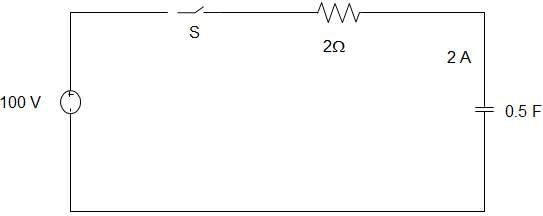
- a)14.7 A
- b)18.5 A
- c)40 A
- d)50 A
Correct answer is option 'A'. Can you explain this answer?
In the circuit given below, the capacitor initially has a charge of 10 C. The current in the circuit at t = 1 sec after the switch S is closed will be ___________


a)
14.7 A
b)
18.5 A
c)
40 A
d)
50 A

|
Cstoppers Instructors answered |
Using KVL, 

or, 

Now, 

Or, 100C – q = (100C – qo) e-t/RC

= 40e-1 = 14.7 A.
If L1 and L2 are the inductances of coil-1 and coil-2, then the total inductance of the magnetic circuit will be represented as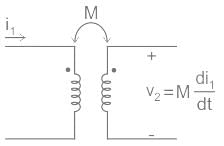
- a)L1 - L2 + M
- b)L1 + L2 + M
- c)L1 + L2 + 2M
- d)L1 + L2 + 3M
Correct answer is option 'C'. Can you explain this answer?
If L1 and L2 are the inductances of coil-1 and coil-2, then the total inductance of the magnetic circuit will be represented as

a)
L1 - L2 + M
b)
L1 + L2 + M
c)
L1 + L2 + 2M
d)
L1 + L2 + 3M
|
|
Zoya Sharma answered |
Concept:
- When inductors are connected in series so that the magnetic field of one links with the other, the effect of mutual inductance either increases or decreases the total inductance depending upon the amount of magnetic coupling.
- The effect of this mutual inductance depends upon the distance apart of the coils and their orientation to each other.
- Mutually connected series inductors can be classed as either “Aiding” or “Opposing” the total inductance.
Mutually Aiding:
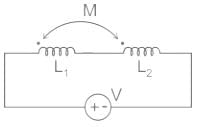
Leq = L1 + L2 + 2M
L : self-inductance
M: Mutual inductance
Mutually Opposing:
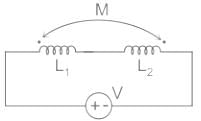
Leq = L1 + L2 – 2M
Basic unit of inductance is ______.- a)Webber
- b)Coulomb
- c)Farad
- d)Henry
Correct answer is option 'D'. Can you explain this answer?
Basic unit of inductance is ______.
a)
Webber
b)
Coulomb
c)
Farad
d)
Henry

|
Ashwani Mishra answered |
Key Points
- Mutual Inductance is the interaction of one coil's magnetic field on another coil as it induces a voltage in the adjacent coil.
- It is the basic operating principle of the transformer, motors, generators and many other electrical components that interact with another magnetic field.
- The mutual inductance between the two coils can be greatly increased by positioning them on a common soft iron core or by increasing the number of turns.
Which of the following has Henry as their SI unit?- a)Inductance
- b)Capacitance
- c)Resistance
- d)Dielectric strength
Correct answer is option 'A'. Can you explain this answer?
Which of the following has Henry as their SI unit?
a)
Inductance
b)
Capacitance
c)
Resistance
d)
Dielectric strength
|
|
Pooja Patel answered |
Concept:
- Inductor: The coil which stores magnetic energy in a magnetic field is called an inductor.
- Inductance: The property of an inductor that causes the emf to generate by a change in electric current is called the inductance of the inductor.
- The SI unit of inductance is Henry (H).
Consider the image given below. According to the image, find out the value of Leq if L is 22 mH.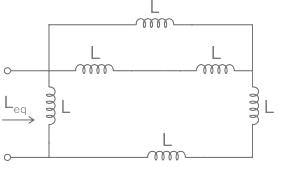
- a)16 mH
- b)100 mH
- c)32 mH
- d)132 mH
Correct answer is option 'A'. Can you explain this answer?
Consider the image given below. According to the image, find out the value of Leq if L is 22 mH.

a)
16 mH
b)
100 mH
c)
32 mH
d)
132 mH

|
Gate Funda answered |
Note: Calculation for series & parallel connection of inductance is same as the resistance:
Application:
We have,
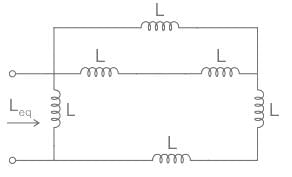
It can be drawn as,
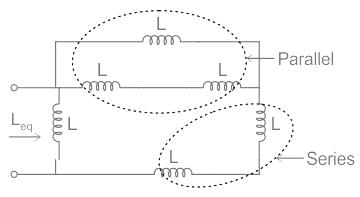
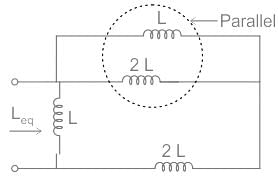
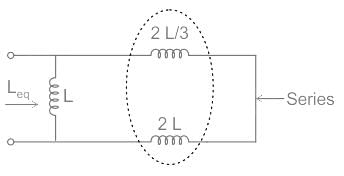
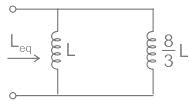
After solving it,
Leq = 16 mH
The energy stored in a coil with inductance L is determined as:- a)

- b)

- c)

- d)

Correct answer is option 'D'. Can you explain this answer?
The energy stored in a coil with inductance L is determined as:
a)

b)

c)

d)

|
|
Zoya Sharma answered |
Current: Rate of flow of charge is known as current. It can be expressed as
I = dq/dt
Where, q = Charge in coulomb
t = time in seconds
The energy stored by an inductor carrying a current I is given by:
Energy, E = 1/2LI2 Joule
Where, L = Inductance of the coil
Now energy stored by inductor can also be expressed as

In the circuit shown in fig. P1.9.9-10, i1 = 5 sin3 A and i2 = 3 cos3t A
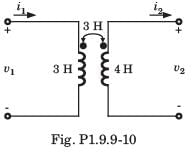
Q. v2 =?- a)9( -4sin 3t + 5 cos 3t) V
- b)9(4sin 3t - 5 cos 3t) V
- c)9( -4sin 3t - 5 cos 3t) V
- d)9(4sin 3t + 5 cos 3t) V
Correct answer is option 'D'. Can you explain this answer?
In the circuit shown in fig. P1.9.9-10, i1 = 5 sin3 A and i2 = 3 cos3t A

Q. v2 =?

Q. v2 =?
a)
9( -4sin 3t + 5 cos 3t) V
b)
9(4sin 3t - 5 cos 3t) V
c)
9( -4sin 3t - 5 cos 3t) V
d)
9(4sin 3t + 5 cos 3t) V
|
|
Aniket Choudhury answered |

= 36 sin 3t + 45 cos 3t = 9 (4sin 3t + 5 cos 3t) V
In the circuit shown in fig. P1.9.7-8, i1= 3 cos3t A and i2 = 4 sin3 A.
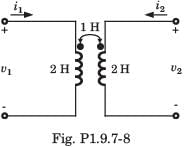
Q. v2 =?- a)3(8cos 3t - 3 sin3t) V
- b)6(2cos t + 3 sint) V
- c)3(8cos 3t + 3 sin 3t) V
- d)6(2cos t - 3 sint) V
Correct answer is option 'A'. Can you explain this answer?
In the circuit shown in fig. P1.9.7-8, i1= 3 cos3t A and i2 = 4 sin3 A.

Q. v2 =?

Q. v2 =?
a)
3(8cos 3t - 3 sin3t) V
b)
6(2cos t + 3 sint) V
c)
3(8cos 3t + 3 sin 3t) V
d)
6(2cos t - 3 sint) V
|
|
Swati Tiwari answered |

= 24 cos 3t - 9 sin 3t = 3 ( 8 cos 3t - 3 sin 3t) V
Consider the circuit shown in fig. P19.5-6
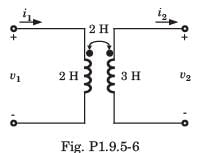
Q. If current i1 = 0 and i2 = 4sin3tA, then voltage v1 and v2 are- a)v1 = 24 cos 3t V, v2 = 36cos 3t V
- b)v1 = 24 cos 3t V, v2 = -36cos 3t V
- c)v1 = -24 cos 3t V, v2 = 36cos 3t V
- d)v1 = -24 cos 3t V, v2 = -36cos 3t V
Correct answer is option 'D'. Can you explain this answer?
Consider the circuit shown in fig. P19.5-6

Q. If current i1 = 0 and i2 = 4sin3tA, then voltage v1 and v2 are

Q. If current i1 = 0 and i2 = 4sin3tA, then voltage v1 and v2 are
a)
v1 = 24 cos 3t V, v2 = 36cos 3t V
b)
v1 = 24 cos 3t V, v2 = -36cos 3t V
c)
v1 = -24 cos 3t V, v2 = 36cos 3t V
d)
v1 = -24 cos 3t V, v2 = -36cos 3t V
|
|
Gargi Basak answered |


= 3di2/dt
= 36cos 3t V
Consider the circuit shown in fig. P19.5-6
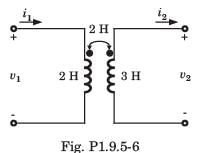
Q. If current i1 = 3 cos4 A and i2 = 0, then voltage v1 and v2 are- a)v1 = -24 sin 4t V, v2 = -24sin 4t V
- b)v1 = 24 sin 4t V, v2 = -36sin 4t V
- c)v1 = -1.5 sin 4t V, v2 = sin 4t V
- d)v1 = -15 sin 4t V, v2 = -sin 4t V
Correct answer is option 'A'. Can you explain this answer?
Consider the circuit shown in fig. P19.5-6

Q. If current i1 = 3 cos4 A and i2 = 0, then voltage v1 and v2 are

Q. If current i1 = 3 cos4 A and i2 = 0, then voltage v1 and v2 are
a)
v1 = -24 sin 4t V, v2 = -24sin 4t V
b)
v1 = 24 sin 4t V, v2 = -36sin 4t V
c)
v1 = -1.5 sin 4t V, v2 = sin 4t V
d)
v1 = -15 sin 4t V, v2 = -sin 4t V
|
|
Ayush Kumar answered |


Chapter doubts & questions for Magnetically Coupled Circuits - 6 Months Preparation for GATE Electrical 2025 is part of Electrical Engineering (EE) exam preparation. The chapters have been prepared according to the Electrical Engineering (EE) exam syllabus. The Chapter doubts & questions, notes, tests & MCQs are made for Electrical Engineering (EE) 2025 Exam. Find important definitions, questions, notes, meanings, examples, exercises, MCQs and online tests here.
Chapter doubts & questions of Magnetically Coupled Circuits - 6 Months Preparation for GATE Electrical in English & Hindi are available as part of Electrical Engineering (EE) exam.
Download more important topics, notes, lectures and mock test series for Electrical Engineering (EE) Exam by signing up for free.
6 Months Preparation for GATE Electrical
795 videos|1417 docs|800 tests
|

Contact Support
Our team is online on weekdays between 10 AM - 7 PM
Typical reply within 3 hours
|
Free Exam Preparation
at your Fingertips!
Access Free Study Material - Test Series, Structured Courses, Free Videos & Study Notes and Prepare for Your Exam With Ease

 Join the 10M+ students on EduRev
Join the 10M+ students on EduRev
|

|
Create your account for free
OR
Forgot Password
OR
Signup to see your scores
go up within 7 days!
Access 1000+ FREE Docs, Videos and Tests
Takes less than 10 seconds to signup

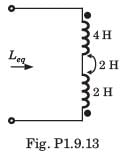

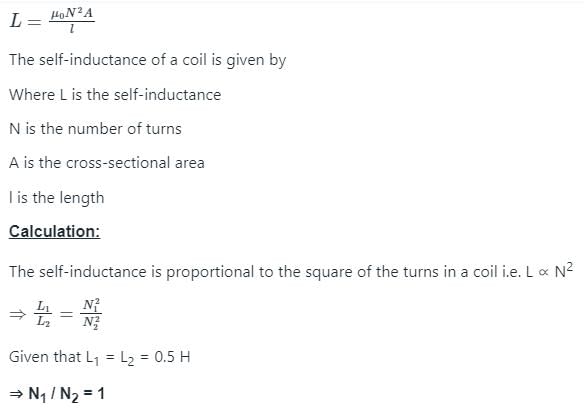 Correct option is D.
Correct option is D.